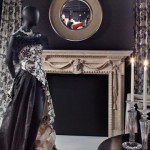McGovern’s MUSE: DreamHome Designers On Renwick’s ’40’
By • May 17, 2012 0 2858
Forty artists under forty years of age will be featured at the Smithsonian American Art Museum’s Renwick Gallery this summer, exploring the evolving notions of craft within traditional media such as ceramics, metalwork, sculpture, industrial design, fashion and sustainable manufacturing.
The artwork selected for the display were all created after Sept. 11, 2001. The exhibit will reflect the changed world that we live in today, posing new challenges and considerations for artists. These artists are united by philosophies for living differently in modern society with an emphasis on sustainability, a return to valuing the hand-made and what it means to live in a state of persistent conflict and unease.
To help gear up for the opening, the D.C. Design Center, which opened its 2012 DreamHome March 15, celebrating eight emerging interior designers, chosen to create rooms inspired by the works to be featured in the “40 Under 40: Craft Futures” exhibit at the Renwick Gallery this July.
Each room in the DreamHome provides inspiration for how the store’s furnishings, fabric and decor can be combined into spectacular residential spaces. The designers were each given a piece of artwork that will be on display this summer and were asked to base their room off of it by exploring color, texture, scale and perspective.
William McGovern, one of the eight chosen interior designers, was assigned the bedroom. His piece of art used for inspiration was Stephanie Liner’s “Momentos of a Doomed Construct.” Created in 2008, Liner uses upholstery, plywood, fabric, sequins, yarn, embroidery, adhesive, cardboard and a live model to illustrate the constrained psyche and tension between masculinity and femininity, architecture and fashion, contemporary and classical.
This piece, although intimidating McGovern at first, couldn’t have been a better selection for the young designer. His passion has always been historic preservation, although he does a lot of modern work. After graduating from Pittsburgh University with a bachelor of arts degree in art history and architecture and then having received a double masters of arts in interior design and historic preservation from Savannah College of Art and Design, he moved to D.C. to work for ForrestPerkins, a architecture and design firm on Wisconsin Avenue. It opened his eyes to a vast array of projects, he said, teaching him more than his own graduate program did.
“I got to do a lot of good high-end projects,” he said. “The Nines Hotel in Portland, Ore., was a lot of contemporary, nostalgic modern, glamourous, but with traditional touches. The Jefferson Hotel, a career maker for me, was a lot of interior architecture details, custom finishes and furnishings.”
McGovern, who left ForrestPerkins after six years to work on his own and stays inspired by and current with the latest trends. He reads magazines, domestic and international, always keeping an eye on what is hot in Europe, knowing that it will eventually become popular in the U.S. “I think if you just work and work and work and don’t look up, your work starts to become stale,” he said.
For him, knowledge of the fashion world and global markets are on his news lists. “The economy has effects on the color palette,” he said. In the early 1980s, the favored color was beige. It became brighter and punchier when the U.S. picked up, moving to luxury textures and patterns. “Then, with the most recent recession, colors went to gray and white,” he said.
No matter the mood of the nation and the most recent trends, McGovern said, “I kind of pride myself in that each project has its own unique set of standards. We’ll talk about concepts, clients, reflecting a sense of history, aesthetics, market appeal, depending on what the property is.”
Lately, McGovern has discovered the need to go green isn’t as much a request as it is a demand. “There are always still needs for incandescent lighting, but it really has almost become kind of an unconscious decision now,” he said in regards to always choosing the most sustainable products when designing. “It has gotten to a point where I almost don’t even think about it first because most companies just have sustainable materials now.”
McGovern Design Studio has revamped several multi-million dollar homes in the city as well as businesses, such as Nectar Skin Bar on the 1600 block of Wisconsin Avenue. His studio is also working on Lafayette Square’s Decatur House, owned by the National Trust and soon to house the history of the White House.
There is no doubt that William McGovern is successful and is being noticed by those in the design world. He believes the D.C. Design Center discovered him after it nominated him in 2011 as one of the “Ones to Watch.”
He has more than earned that title in this year’s DreamHome as he creatively captured exactly what inspired artist Stephanie Liner in her work. “It’s all about tension,” he said. “She uses really feminine patterns symbolizing beauty and then very rigid architecture to make the structure symbolize masculinity. We took that approach very literally in the design of the room.”
McGovern matched the art piece’s whimsical and surreal mood. Liner created an orb with wood and medal and then upholstered it with a floral fabric. Inside the structure is a live model, indulged by her surroundings, wearing the same fabric as the exterior. To turn this art into a bedroom, McGovern showed the balance of tension by using masculine colors like black and white but contrasting them with a lipstick red painted French poster bed, patterned draperies and a black woven wall covering, but with silver metallic threading to make it sparkle with a touch of femininity.
The room also features a mannequin, whose dress is coming from the flow of the drapery on the window behind her, capturing the same essence of the model’s dress being the exact fabric as the orb.
“As with Ms. Liner’s work, the room we created symbolizes the universal notions of beauty, fashion, gender and the internal struggle to impose societal pressures upon one’s self,” McGovern said.
This bedroom, and the rest of the 2012 DreamHome, will be on display at the D.C. Design Center through Nov. 30.
THE OTHER DESIGNERS:
Shanon Munn, of Ambi Design Studio, designs sophisticated, comfortable spaces while enhancing the client’s personal style. She prefers to highlight surrounding architecture and use eco-friendly materials whenever possible, such as low- VOC paint, when designing any space from residential to hospitality to commercial properties. The DreamHome team chose Munn to design the office space. Munn wanted to evoke a strong, powerful, feminine presence. “Vera Wang was our muse,” she said. “Like our inspiration piece (Crane Chair by Christy Oates, an inlaid wall-art piece that turns into a functional chair), we utilized a fairly neutral palette with pops of color.” She said her projects are always very tailored as she asks to see inspirational pieces, which have been as varied as handbags and table settings. “In that regard,” she said, “this was a very natural way for me to design.”
Scott Cooke of Scott Cooke Design, started out in the fashion industry before attaining a BFA in Interior Design. A multi-faceted designer, Cooke credits his grandfather who commissioned famed architect, Frank Lloyd Wright, to build the house he spent many years in as a kid in Virginia Beach. The home impacted Cooke and the designs and styles in the home stay with him today as he works from his studio in Logan Circle. He created the living room in the DreamHome, which is inspired by Cristina Córdova’s “Dulce.” He produced a nineteenth century drawing room, keeping the backdrop of the room neutral but made bright and bold colors pop for dramatic effect in the drapery panels, pillows and artwork on the walls.
Jeff Akseizer and Jamie Brown, of Akseizer Design Group, look to always create a great functioning room paired with outstanding form. Aksiezer has been a design professional in Washington for over 10 years and has won local and national awards. Brown has completed projects all over the east coast and has been featured in both the Washington Times and Washington Spaces magazine. The Akseizer Design Group purchased and developed their own millwork factory in Boswell, PA in 2008 to produce custom case goods to use in their homes and buildings. Akseizer and Brown created the Modern Lounge room in the DreamHome, inspired by an art piece by Shawn Smith.
Miriam Dillon leads the interior design department of Barnes Vanze Architects, Inc. She has practiced architecture and interior design for over 18 years. For the DreamHome, Dillon designed the modern study with comfortable furniture, mixed metals, decorative accents and a splash of color inspired by artist Sabrina Gschwandtner’s Hula Hoop piece.
Catherine Hailey, of Hailey Design LLC, specializes in contemporary residential work as well as restaurant and retail design. She has traveled all over the world to design in cities like Miami, Aspen, Paris and Hong Kong. Hailey has designed DC area restaurants like Rustico, Buzz, Evening Star, Masa 14, Birth and Barley/Churchkey. She believes her contemporary style and texture and material choices are part of the reason she was chosen to help design the DC DreamHome. She worked on the dining room and entertainment area at the Design Center, inspired by Uhuru’s Cyclone Chaise Lounge. She hopes to continue working on contemporary spaces using green products. She said clients mainly seem to be concerned with the bottom line cost and the end aesthetic result of the project, however, she hopes the green trend will continue so that the cost of the materials will go down and the variety will increase.
Christine Philp, of Palindrome Design, has worked on properties in D.C., Bel-Air, Calif. and Southampton, N.Y. She’s been told she has an eye for color, scale and form and designs rooms that delight, while remaining sensitive to budget. Her breakfast room in the DreamHome was inspired by Lara Knutson’s “Soft Glass Basket,” a woven basket made from reflective glass fabric and steel wire. When designing the room, Philp played off of the natural curved lines and organic feel of the piece, incorporating elements of metal on various pieces of furniture in the room.
Kori Keyser, of Keyser Interiors, Inc. brought her 16 years of experience in designing homes to DC DreamHome’s Sitting Room inspired by Andy Paiko’s Spinning Wheel, made from blown glass, cocobolo wood, steel, brass and leather. She said the room is perfect for someone to read or enjoy a glass of wine alone, but is also inviting for a small gathering. Keyser holds a Bachelor of Science in Interior Design from La Roche College in Pittsburgh and is a professional member of ASID and NCIDQ certified. In the future, she’d love to design a line of furniture.
- Jordan Wright




















